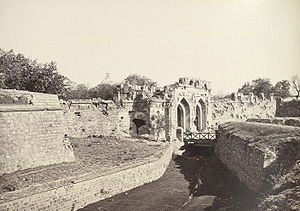
Back حصار دلهي Arabic Sieĝo de Delhio Esperanto محاصره دهلی Persian Delhin piiritys Finnish દિલ્હીનો ઘેરો Gujarati המצור על דלהי (1857) HE ഡെൽഹി പിടിച്ചടക്കൽ Malayalam Осада Дели (1857) Russian Опсада Делхија Serbian Belägringen av Delhi Swedish
| Siege of Delhi | |||||||
|---|---|---|---|---|---|---|---|
| Part of the Indian Rebellion of 1857 | |||||||
 Battle damage to the Kashmiri Gate in Delhi, 1857. | |||||||
| |||||||
| Belligerents | |||||||
|
| |||||||
| Commanders and leaders | |||||||
| Strength | |||||||
|
3,000 regular 6000 Sikhs, Punjabis, and Gurkhas[1][2] 2,200 Kashmiri irregulars[3] 42 field guns 60 siege guns |
12,000 sepoys, approx. 30,000 irregulars or mujahideen,[4] approx. 100 guns | ||||||
| Casualties and losses | |||||||
|
1,254 killed 4,493 wounded | approx. 5,000 killed and wounded | ||||||
The Siege of Delhi was one of the decisive conflicts of the Indian Rebellion of 1857. The rebellion against the authority of the East India Company was widespread through much of Northern India, but essentially it was sparked by the mass uprising by the sepoys of the Bengal Army, which the company had itself raised in its Bengal Presidency (which actually covered a vast area from Assam to Peshawar). Seeking a symbol around which to rally, the first sepoys to rebel sought to reinstate the power of the Mughal Empire, which had ruled much of the Indian subcontinent in the previous centuries. Lacking overall direction, many who subsequently rebelled also flocked to Delhi.
This made the siege decisive for two reasons. Firstly, large numbers of rebels were committed to the defence of a single fixed point, perhaps to the detriment of their prospects elsewhere, and their defeat at Delhi was thus a very major military setback. Secondly, the British recapture of Delhi and the refusal of the aged Mughal Emperor Bahadur Shah II to continue the struggle deprived the rebellion of much of its national character. Although the rebels still held large areas, there was little co-ordination between them, and the British were able to overcome them separately.
- ^ "Siege of Delhi | Summary". Encyclopædia Britannica. Retrieved 7 June 2021.
- ^ Latter, Mick (14 September 2020). "Delhi Day – Gurkhas at the Siege of Delhi, 1857". Welcome to the Gurkha Brigade Association. Retrieved 7 June 2021.
- ^ Roberts (1893), p.116
- ^ Dalrymple, William. The Last Mughal-Fall of a dynasty Delhi 1857. Bloomsbury Publishing. pp. 269–270.
© MMXXIII Rich X Search. We shall prevail. All rights reserved. Rich X Search